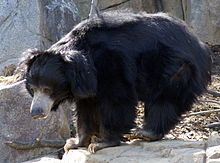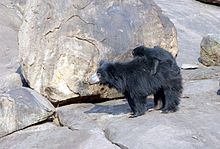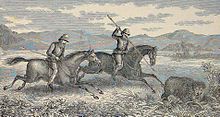- Sloth bear
-
Sloth bear
Temporal range: Late Pliocene to Early Pleistocene – RecentFrancois [1] a sloth bear in captivity at the Smithsonian National Zoological Park, Washington, DC. Conservation status Scientific classification Kingdom: Animalia Phylum: Chordata Class: Mammalia Order: Carnivora Family: Ursidae Genus: Ursus Species: U. ursinus Binomial name Ursus ursinus
(Shaw, 1791)
Sloth bear range
(green – extant, black – former)Synonyms The sloth bear (Ursus ursinus[3] =Melursus ursinus), also known as the labiated bear,[4] is a nocturnal insectivorous species of bear found wild within the Indian subcontinent. The sloth bear evolved from ancestral brown bears during the Pleistocene and shares features found in insect-eating mammals through convergent evolution. The population isolated in Sri Lanka is considered as a subspecies. Unlike brown and black bears, sloth bears have lankier builds, long shaggy coats that form a mane around the face, long sickle shaped claws, and a specially adapted lower lip and palate used for sucking insects. Sloth bears breed during spring and early summer and give birth near the beginning of winter. They feed on termites, honeybee colonies and fruits. Sloth bears sometimes attack humans that encroach on their territory. Historically, humans have drastically reduced their habitat and diminished their population by hunting them for food and products such as their baculum and claws. These bears have been used for as performing pets due to their tameable nature.
Contents
Naming and etymology
Initially thought to be related to the South American sloths, Shaw and Nodder in 1791 called it Bradypus ursinus noting that it was bear-like but giving weight to the long claws and the absence of upper middle incisors. Meyer (1793) identified it as a bear and called it Melursus lybius and in 1817, de Blainville called it Ursus labiatus because of the long lips. Iliger called it Prochilus hirsutus, the Greek genus name indicating long lips while the specific name noted its long and coarse hair. Fischer called it Chondrorhynchus hirsutus while Tiedemann called it Ursus longirostris.[5]
Local names
- Bengali: Bhalluk[6]
- Kannada and 'Tamil: Kardi or கரடி, Karadi[6]
- Gond: Yerid, Yedjal and Asol[6]
- Hindi: Rinch, Bhalu and Adam-zad[6]
- Marathi: Aswal, अस्वल[6]
- Kol: Bana[6]
- Malayalam: Pani karudi[6]
- Oraon: Bir Mendi[6]
- Sanskrit: Riksha, Bhalluka[6]
- Telugu: ఎలుగుబంటి[6]
- Sinhala: Walaha[7]
- Gujarati: Rinchh[6]
Evolution
Sloth bears may have reached their current form in the early Pleistocene, the time when the bear family specialized and dispersed. A fragment of fossilized humerus from the Pleistocene, found in Andhra Pradesh's Kurnool Basin is identical to the modern sloth bear's. The fossilized skulls of a bear once named Melursus theobaldi found in the Shivaliks from the early Pleistocene or early Pliocene are thought by certain authors to represent an intermediate stage between sloth bears and ancestral brown bears. M. theobaldi itself had teeth intermediate in size between sloth bears and other bear species, though its palate was the same size as the former species, leading to the theory that it is the sloth bear's direct ancestor. Sloth bears probably arose during the mid-Pliocene and evolved in the Indian subcontinent. The sloth bear bears evidence of having undergone a convergent evolution similar to that of other ant-eating mammals.[8]
Physical description
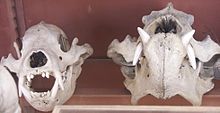 Skulls of a Sri Lankan sloth bear (left) and a common sloth bear (right) from the Muséum national d'histoire naturelle
Skulls of a Sri Lankan sloth bear (left) and a common sloth bear (right) from the Muséum national d'histoire naturelle
Sloth bears are distinguished from Asian black bears by their lankier builds, longer, shaggier coat, pale muzzle and white claws.[9] Sloth bear muzzles are thick and long, with small jaws and bulbous snouts with wide nostrils. They have long lower lips which can be stretched over the outer edge of the nose, and lack upper incisors, thus allowing them to suck up large numbers of insects. The premolars and molars are smaller than in other bears, as they do not chew as much vegetation. In adults, the teeth are usually in poor condition, due to the amount of dirt they suck up and chew when feeding on insects.[10] The back of the palate is long and broad, as is typical in other ant-eating mammals.[8] The paws are disproportionately large, and have highly developed, sickle shaped blunt claws which measure 4 inches in length. Their toe pads are connected by a hairless web. They have the longest tail in the bear family, which can grow to 6–7 inches.[10] Their back legs are not very strong, though they are knee-jointed, and allow the sloth bear to assume almost any position.[11] The ears are very large and floppy. Sloth bear fur is completely black (rusty for some specimens), save for a whitish Y or V shaped mark on the chest.[10] This feature is sometimes absent, particularly in Sri Lankan specimens.[8] This feature, which is also present in Asian black bears and sun bears, is thought to serve as a threat display, as all three species are sympatric with tigers.[8] The coat is long, shaggy and unkempt, and is particularly heavy behind the neck and between the shoulders, forming a mane which can be 30 cm long.[8][10] The belly and underlegs are almost bare. Adult sloth bears weigh 100 kg (220 lbs) on average, though weight can range variously from 55 kg (121 lbs) to 190 kg (400 lbs).[12][13] They are 60–90 cm (2–3 ft) high at the shoulder, and have a body length of 1.4–1.9 m (4.6–6.3 ft).[10][14][15][16] Females are smaller than males, and have more fur between the shoulders.[11]
Behavior
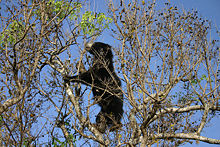 A Sri Lankan sloth bear on a tree
A Sri Lankan sloth bear on a tree
Adult sloth bears may travel in pairs, with the males being gentle with cubs. They may fight for food. They walk in a slow, shambling motion, with their feet being set down in a noisy, flapping motion. They are capable of galloping faster than running humans.[17] Although they appear slow and clumsy, sloth bears are excellent climbers. They climb to feed and rest, though not to escape enemies, as they prefer to stand their ground. They are capable of climbing on smooth surfaces and hang upside down like sloths.[10] They are good swimmers, and primarily enter water to play.[10] To mark their territory, sloth bears will scrape trees with their forepaws, and rub against them with their flanks.[17] Sloth bears have a great vocal range. Gary Brown, in his Great Bear Almanac lists over 25 different sounds in 16 different contexts. Sounds such as barks, screams, grunts, roars, snarls, wickers, woofs and yelps are made when angered, threatening or when fighting. When hurt or afraid, they shriek, yowl or whimper. When feeding, sloth bears make loud huffing and sucking noises,[17] which can be heard over 100 metres away.[10] Sounds such as gurgling or humming are made by bears resting or sucking their paws. Sows will emit crooning sounds to their cubs. The species is the most vociferous when mating, and make loud, melodious calls when doing so. Sloth bears do not hibernate. They make their day beds out of broken branches in trees, and will rest in caves during the wet season. Sloth bears are the most nocturnal of bears, though sows become more active in daytime when with cubs.[17]
Reproduction
The breeding season for sloth bears varies according to location: in India, they mate in April, May and June, and give birth in December and early January, while in Sri Lanka, it can be done all year. Sows gestate for 210 days near about 7 months, and typically give birth in caves or in shelters under boulders. Litters usually consist of 1–2 cubs, rarely 3.[17] Cubs are born blind, and open their eyes after four weeks.[6] Sloth bear cubs develop quickly compared to most other bear species: they will start walking a month after birth, become independent at 24–36 months, and become sexually mature at the age of 3 years. Young cubs will ride on their mother's back when she walks, runs or climbs trees until they reach a third of her size. Individual riding positions are maintained by cubs through fighting. Intervals between litters can last 2–3 years.[17]
Dietary habits
Sloth bears are expert hunters of termites, which they locate by smell.[17] On arriving at an ant-hill, they scrape at the structure with their claws till they reach the large combs at the bottom of the galleries, and will disperse the dirt with violent puffs. The ants are then sucked up through the muzzle, producing a hoovering sound which can be heard 180 meters away.[6] Their olfactory senses are strong enough to detect grubs three feet below ground. Unlike other bears, they do not congregate in feeding groups. They rarely prey on other mammals.[17] Sloth bears may supplement their diet with fruit and plant matter: in March and April, they will eat the fallen petals of mowha trees and are partial to mangoes, sugar cane, the pods of the Golden Shower Tree and the fruit of the jack-tree. Sloth bears are extremely fond of honey.[6] When feeding their cubs, sows are reported to regurgitate a mixture of half digested jack fruit, wood apples[disambiguation needed
 ] and pieces of honey comb. This sticky substance hardens into a dark yellow circular bread-like mass which is fed to the cubs. This "bear's bread" is considered a delicacy by some of India's natives.[18]
] and pieces of honey comb. This sticky substance hardens into a dark yellow circular bread-like mass which is fed to the cubs. This "bear's bread" is considered a delicacy by some of India's natives.[18]Relationships with other animals
Bengal tigers will occasionally prey on sloth bears. Tigers usually give sloth bears a wide berth, though some specimens may become habitual bear killers[19] and it is not uncommon to find sloth bear fur in tiger scats.[20] Tigers typically hunt sloth bears by waiting for them near termite mounds, then creep behind them and seize them by the back of their necks and force them to the ground with their weight.[21] One tiger was reported to simply break its victim's back with its paw, then wait for the paralysed bear to exhaust itself trying to escape before going in for the kill.[19] When confronted by tigers face to face, sloth bears will charge at them, crying loudly. A young, or already satiated tiger will usually retreat from an assertive sloth bear, as the bear's claws can inflict serious wounds, and most tigers end the hunt if the bears become aware of the tiger's presence before the pounce.[21] A female bear with cubs was observed to stand its ground and prevail in a confrontation against two tigers (one female, one male) in rapid succession.[22] Sloth bears may scavenge on tiger kills.[23] As tigers are known to mimic the calls of sambar deer to attract them, sloth bears react fearfully even to the sounds made by deer themselves.[21] Indian leopards can also be a threat, as they are able to follow sloth bears up trees.[24] Sloth bears will occasionally chase leopards from their kills.[17]
Sloth bears are sympatric with Asiatic black bears in Northern India, and the two species, along with the sun bear, co-exist in some of the national parks and wildlife sanctuaries. They are also found together in Assam, Manipur and Mizoram, in the hills south of the Brahmaputra river, the only places occupied by all three bear species. The three species do not act aggressively toward each other.[24]
Dhole packs may attack sloth bears, though they are not a usual prey item.[25] When attacking sloth bears, dholes will try to prevent the bear from retreating in caves.[26]
Asian elephants apparently do not tolerate sloth bears in their vicinity. The reason for this is unknown, as individual elephants known to maintain their composure near tigers have been reported to charge bears.[6] Indian rhinoceros have a similar intolerance for sloth bears, and will charge at them.[17]
Subspecies and range
Name Distribution Description Sri Lankan sloth bear (Melursus ursinus inornatus) Pucheran, 1855

Sri Lanka Sri Lankan sloth bears have much shorter body hair, making them appear less shaggy. They are also smaller in dimensions, even in the teeth. They sometimes lack the characteristic white chest mark.[8] At the turn of the century, sloth bears were found throughout Sri Lanka, but reduced in number after the turn of the century, due to wide-scale conversion of upland forests into tea and coffee plantations. They are now restricted to the northern and eastern lowlands.[27] Common sloth bear (Melursus ursinus ursinus) (Shaw, 1791) 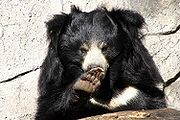
India, Nepal, Bhutan, Bangladesh and Pakistan In India, their distribution is patchy, and mostly occur in areas of forest cover. They are absent in the high mountains of Himachal Pradesh and Jammu and Kashmir, the northwestern deserts of Rajasthan, and a broad non-forested swath in the south. Sloth bears are the most widespread bear species in India, being found in the Siwaliks(also in Pakistan) , low hills bordering the outer range of the Himalayas from Punjab to Arunachal Pradesh, though they are no longer found as far west as Punjab. They are isolated from the sloth bear populations of Nepal, due to the connection being broken by agricultural lands. Sloth bears in Nepal are mainly restricted to the Terai, the southern strip of lowland forest and grasslands bordering India. A few isolated populations may still occur in the Chittagong and Sylhet regions of eastern Bangladesh.[27] Relationships with humans
Attacks on humans
According to Robert Armitage Sterndale, in his Mammalia of India (1884, p. 62):
[The sloth bear] is also more inclined to attack man unprovoked than almost any other animal, and casualties inflicted by it are unfortunately very common, the victim being often terribly disfigured even if not killed, as the bear strikes at the head and face. Blanford was inclined to consider bears more dangerous than tigers...
Captain Williamson in his Oriental Field Sports wrote of how sloth bears rarely killed their human victims outright, but would suck and chew on their limbs till they were reduced to bloody pulps.[4] One specimen, known as the Sloth bear of Mysore, was singlehandedly responsible for the deaths of 12 people and the mutilation of 2 dozen others before being shot by Kenneth Anderson.[28] Although sloth bears have attacked humans, they rarely become man-eaters. Dunbar-Brander's Wild Animals of Central India mentions a case in which a sow with two cubs began a six week reign of terror in Chanda, a district of the Central Provinces, during which more than one of their victims had been eaten,[29] while the sloth bear of Mysore partially ate at least three of its victims.[28] R.G. Burton deduced from comparing statistics that sloth bears killed more people than Asian black bears,[29] and Theodore Roosevelt considered them to be more dangerous than American black bears.[30] In Madhya Pradesh, sloth bear attacks accounted for the deaths of 48 people and the injuring of 686 others between the years 1989 and 1994, probably due in part to the density of population and competition for food sources.[31] A total of 137 attacks (resulting in 11 deaths) occurred between April 1998 and December 2000 in the North Bilaspur Forest Division of Chhattisgarh. The majority of attacks were perpetrated by single bears, and occurred in kitchen gardens, crop fields, and in adjoining forests during the monsoon season.[32] One Mr. Watts Jones wrote a first hand account of how it feels to be attacked by a sloth bear, recalling when he failed to score a direct hit against a bear he had targeted:
I do not know exactly what happened next, neither does my hunter who was with me ; but I believe, from the marks in the snow, that in his rush the bear knocked me over backwards in fact, knocked me three or four feet away. When next I remember anything, the bear's weight was on me, and he was biting my leg. He bit two or three times. I felt the flesh crush, but I felt no pain at all. It was rather like having a tooth out with gas. I felt no particular terror, though I thought the bear had got me; but in a hazy sort of way I wondered when he would kill me, and thought what a fool I was to get killed by a stupid beast like a bear. The shikari then very pluckily came up and fired a shot into the bear, and he left me. I felt the weight lift off me, and got up. I did not think I was much hurt. ... The main wound was a flap of flesh torn out of the inside of my left thigh and left hanging. It was fairly deep, and I could see all the muscles working underneath when I lifted it up to clean the wound."[33]
It is likely that sloth bears view humans as predators, as their reactions to them (roaring, followed by retreat or charging) are similar to those evoked in the presence of tigers and leopards.[8]
Hunting and products
One method of hunting sloth bears involved the use of beaters, in which case, a hunter waiting on a post could either shoot the approaching bear through the shoulder or on the white chest mark if it was moving directly to him. Sloth bears are very resistant to body shots, and can charge hunters if wounded, though a man of steady nerves could score a direct hit from within a few paces of a charging bear. Sloth bears were easy to track during the wet season, as their clear footprints could be followed straight to their lairs. The majority of sloth bears killed in forests were due to chance encounters with them during hunts for other game. In hilly or mountainous regions, two methods were used to hunt sloth bears there: one was to lie in wait above the bear's lair at dawn and wait for the bear to return from its nocturnal foraging. Another was to rouse them at daytime by firing flares into the cave to draw them out.[34] Sloth bears were also occasionally speared on horseback.[27] In Sri Lanka, the baculum of a sloth bear was once used as a charm against barrenness.[11]
Tameability
 A tame bear and its handler in Pushkar
A tame bear and its handler in Pushkar
Officers in British India often kept sloth bears as pets.[6] The wife of Kenneth Anderson kept an orphaned sloth bear cub from Mysore, which she christened "Bruno". The bear could be fed on almost anything (including motor oil) and was very affectionate toward people. It was even taught numerous tricks, such as cradling a woodblock like a baby or pointing a bamboo stick like a gun.[35]
Dancing bears were historically a popular entertainment in India, dating back to the 13th century and the pre-Mughal era. The Kalandars, who practised the tradition of capturing sloth bears for entertainment purposes, were often employed in the courts of Mughal emperors to stage spectacles involving trained bears.[6] They were once common in the towns of Calcutta, where they often disturbed the horses of British officers.[6]
Despite a ban on the practice that was enacted in 1972, there were as many as 800 dancing bears in the streets of India during the latter part of the 20th century, particularly on the highway between Delhi, Agra, and Jaipur. Sloth bear cubs, which were usually purchased at the age of six months from traders and poachers, were trained to dance and follow commands through coercive stimuli and starvation. Males were castrated at an early age, and their teeth were knocked out at the age of one year in order to prevent them from seriously injuring their handlers. The bears were typically fitted with a nose ring attached to a four foot leash. Some were found to be blind from malnutrition.[36]
In 2009, following a seven year campaign by a coalition in Indian and international animal welfare groups, the last Kalandar dancing bear was set free.[37] The effort to end the practice involved helping the bear handlers find jobs and education, which enabled them to reduce their reliance on dancing bear income.[38]
Cultural references
In Rudyard Kipling's The Jungle Book, Baloo "the sleepy old grey bear" teaches the Law of the Jungle to the wolf cubs of the Seeonee wolf pack, as well as to his most challenging pupil, the "man-cub" Mowgli. Robert Armitage Sterndale, from whom Kipling derived most of his knowledge of Indian fauna, used the Hindustani word "Bhalu" for several bear species, though Daniel Karlin, who edited the Penguin reissue of The Jungle Book in 1989 states that with the exception of colour, Kipling's descriptions of Baloo are consistent with the sloth bear, as brown bears and Asian black bears do not occur in the Seoni area where the novel takes place. Also, the name "sloth" can be used in the context of sleepiness. Karlin states however that Baloo's diet of ".. only roots and nuts and honey" is a trait more common to the Asian black bear than to the sloth bear.[39]
References
- ^ Sloth Bears. Smithonian National Zoological Park
- ^ Garshelis, D.L., Ratnayeke S. & Chauhan, N.P.S. (2008). Melursus ursinus. In: IUCN 2008. IUCN Red List of Threatened Species. Downloaded on 26 January 2009.Listed as Vulnerable (VU A2cd+4cd, C1 v3.1)
- ^ Krause, J.; Unger, T.; Noçon, A.; Malaspinas, A.; Kolokotronis, S.; Stiller, M.; Soibelzon, L.; Spriggs, H.; Dear, P. H.; Briggs, A. W.; Bray, S. C. E.; O'Brien, S. J.; Rabeder, G.; Matheus, P.; Cooper, A.; Slatkin, M.; Pääbo, S.; Hofreiter, M. (2008). "Mitochondrial genomes reveal an explosive radiation of extinct and extant bears near the Miocene-Pliocene boundary". BMC Evolutionary Biology 8 (220): 220. doi:10.1186/1471-2148-8-220. PMC 2518930. PMID 18662376. http://www.pubmedcentral.nih.gov/articlerender.fcgi?tool=pmcentrez&artid=2518930.
- ^ a b The forest, the jungle, and the prairie or, Scenes with the trapper and the hunter in many lands by Alfred Elliott. Publisher T. Nelson, and Sons, Paternoster Row; Edinburgh; and New York., 1868
- ^ Owen, R (1833). "The Labiated Bear". The Zoological Magazine. Number 3: 81–85. http://www.archive.org/stream/zoologicalmagazi00owen#page/81/mode/1up.
- ^ a b c d e f g h i j k l m n o p q r US.Archive.org, Sterndale's Mammalia of India, A New and Abridged Edition, thoroughly revised and with an Appendix on the Reptilia by Frank Finn, B.A., F.Z.S. Late Deputy Superintendent Indian Museum, Calcutta, 1929
- ^ IAR.org.uk[dead link]
- ^ a b c d e f g Comcast.net, Sloth Bear Melursus ursinus, Final draft: Chapter for the book “Mammals of South Asia” (Eds. Johnsingh, A. J. T. and Manjrekar, N.), Authors: K. Yoganand, Clifford G. Rice and A. J. T. Johnsingh
- ^ WildLifeInformation.org, Melursus ursinus – Sloth bear
- ^ a b c d e f g h Bear Anatomy and Physiology from Gary Brown's The Great Bear Almanac, Lyons & Burford, Publishers, 1993
- ^ a b c Harry Storey (31 May 2008). Hunting and Shooting in Ceylon. Dabney Press. pp. 268–. ISBN 978-1-4097-2852-8. http://books.google.com/books?id=WOxoRzoD9PsC&pg=PA268. Retrieved 26 September 2011.
- ^ Brian K. McNab (1992). "Rate of Metabolism in the Termite-Eating Sloth Bear (Ursus ursinus)". Journal of Mammalogy 73 (1): 168–172. doi:10.2307/1381879. JSTOR 1381879.
- ^ "Sloth bear videos, photos and facts – Melursus ursinus". ARKive. http://www.arkive.org/sloth-bear/melursus-ursinus/. Retrieved 2011-04-18.
- ^ "Sloth Bear". The Animal Files. http://www.theanimalfiles.com/mammals/carnivores/bear_sloth.html. Retrieved 2011-04-18.
- ^ "Sloth Bear". Arktofile.net. http://arktofile.net/pages/bear_sloth.html. Retrieved 2011-04-18.
- ^ "San Diego Zoo's Animal Bytes: Sloth Bear". Sandiegozoo.org. http://www.sandiegozoo.org/animalbytes/t-sloth_bear.html. Retrieved 2011-04-18.
- ^ a b c d e f g h i j Bear Behavior and Activities from Gary Brown's The Great Bear Almanac, Lyons & Burford, Publishers, 1993
- ^ Anderson, Kenneth (1954). Nine Man-Eaters and One Rogue. p. 251. ISBN 1887269118.
- ^ a b Mills, Stephen (2004). Tiger. Richmond Hill., Ont.: Firefly Books. p. 168. ISBN 1552979490.
- ^ Tigers eat sloth bears, don’t they?
- ^ a b c Perry, Richard (1965). The World of the Tiger. p. 260. ASIN: B0007DU2IU.
- ^ Bear Tiger confrontation – 10 pics that tell a story. Dickysingh.com (2011-04-10). Retrieved on 2011-09-26.
- ^ The Deer and the Tiger: A Study of Wildlife in India, Midway Reprint, Author George B. Schaller, Edition reprint, illustrated, University of Chicago Press, 1984, ISBN 0226736318
- ^ a b Barbara Hadley The Sloth Bear. IUCN/SSC. Bear Specialist Group. IAR.org.uk
- ^ Fox, Michael W. (1984). The Whistling Hunters: Field Studies of the Asiatic Wild Dog (Cuon Alpinus). Albany: State University of New York Press. p. 150. ISBN 0873958438. http://www.amazon.com/dp/0873958438.
- ^ Animal Kingdom of the World, Author S.K. Tiwari, Publisher Sarup & Sons, 1999, ISBN 8176250716
- ^ a b c David L. Garshelis, Anup R. Joshi, James L. D. Smith, and Clifford G. Rice. "Sloth Bear Conservation Action Plan" (PDF). http://wildlife1.wildlifeinformation.org/000ADOBES/Bears/Bears_IUCN_ActionPlan/bearsAP_chapter12.pdf. Retrieved 2011-04-18.
- ^ a b “The Black Bear of Mysore”, from Man-Eaters and Jungle Killers, Kenneth Anderson, Allen & Unwin, 1957
- ^ a b A Book of Man Eaters by Brigadier General R.G. Burton, Mittal Publications
- ^ Ranch Life and the Hunting Trail by Theodore Roosevelt, Published by U of Nebraska Press, 1983, ISBN 0803289138]
- ^ Rajpurohit, K. S. and P. R. Krausman (2000). "Human – sloth-bear conflicts in Madhya Pradesh, India". Wildl. Soc. Bull. 28 (2): 393–9. JSTOR 3783697.
- ^ Bargali, H. S.; Akhtar, Naim; Chauhan, N. P. S. (2005). "Characteristics of sloth bear attacks and human casualties in North Bilaspur Forest Division, Chhattisgarh, India". Ursus 16 (2): 263–267. doi:10.2192/1537-6176(2005)016[0263:COSBAA]2.0.CO;2. ISSN 1537-6176. http://www.bearbiology.com/fileadmin/tpl/Downloads/URSUS/Vol_16_2/Bargali_Akhtar_16_2_.pdf.
- ^ "''The living animals of the world; a popular natural history with one thousand illustrations'' Volume 1: Mammals, by Cornish, C. J. (Charles John), 1858–1906; Selous, Frederick Courteney, 1851–1917; Johnston, Harry Hamilton, Sir, 1858–1927; Maxwell, Herbert, Sir, published by New York, Dodd, Mead and Company". Archive.org. http://www.archive.org/stream/livinganimalsofw01cornrich#page/n7/mode/2up. Retrieved 2011-04-18.
- ^ C. E. M. Russell (21 October 2008). Bullet and Shot in Indian Forest, Plain and Hill – With Hints to Beginners in Indian Shooting.. Phillips Press. pp. 197–. ISBN 978-1-4437-6231-1. http://books.google.com/books?id=bWy9B80bA6YC&pg=PA197. Retrieved 26 September 2011.
- ^ 9. The Bond of Love[dead link]
- ^ Dancing Bears in India. wildlifesos.org
- ^ "Last Indian dancing bear set free". BBC News. 2009-12-18. http://news.bbc.co.uk/2/hi/south_asia/8421867.stm. Retrieved 2011-04-18.
- ^ "Katrick Satyanarayan: How we rescued the "dancing" bears". Ted.com. http://www.ted.com/talks/kartick_satyanarayan_how_we_rescued_the_dancing_bears.html. Retrieved 2011-04-18.
- ^ Rudyard Kipling; Daniel Karlin (1989). The jungle books. Penguin. pp. 350–. ISBN 978-0-14-018316-0. http://books.google.com/books?id=UrJOKXFEPAwC&pg=PA350. Retrieved 26 September 2011.
External links
- Field Trip Earth – Field Trip Earth is a conservation education website operated by the North Carolina Zoological Society.
- Sloth Bear at Animal Diversity Web
Categories:- IUCN Red List vulnerable species
- Bears
- Myrmecophagous mammals
- Mammals of Nepal
- Megafauna of Eurasia
- Mammals of Sri Lanka
- Mammals of India
- Monotypic mammal genera
Wikimedia Foundation. 2010.

